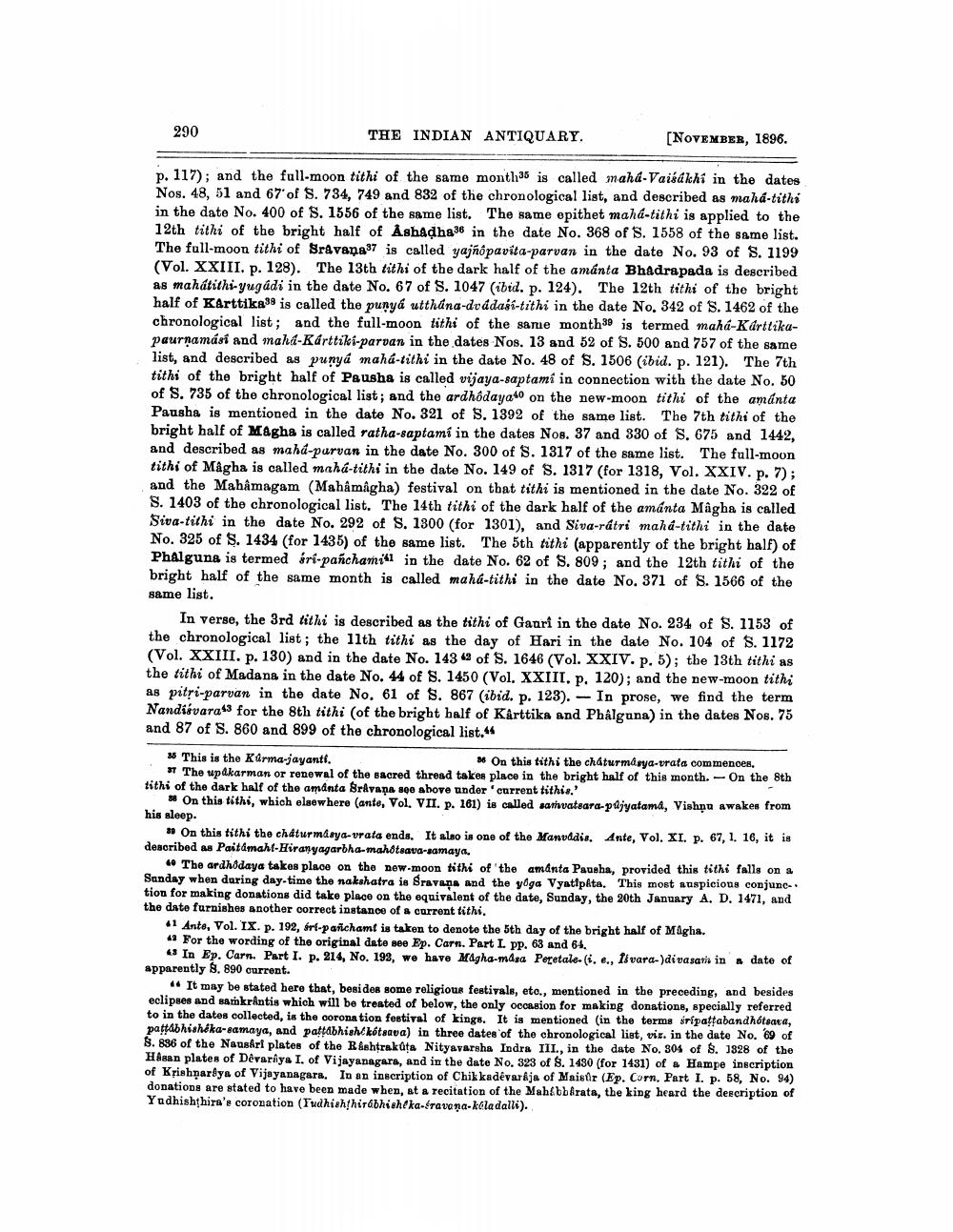________________
290
THE INDIAN ANTIQUARY.
[NOVEMBER, 1896.
p. 117); and the full-moon tithi of the same month36 is called mahd.Vaisakhi in the dates Nos. 48, 51 and 67' of S. 734, 749 and 832 of the chronological list, and described as mahá-titha in the date No. 400 of S. 1556 of the same list. The same epithet mahd-tithi is applied to the 12th tithi of the bright half of Åshadha36 in the date No. 368 of S. 1558 of the same list. The full-moon tithi of Sravana37 is called yajñópavíta-parvan in the date No. 93 of S. 1199 (Vol. XXIII. p. 128). The 13th tithi of the dark half of the amanta Bhadrapada is described as mahátithi-yugádi in the date No. 67 of S. 1047 (ibid. p. 124). The 12th tithi of the bright half of Karttika39 is called the punya utthana-dvádasi-tithi in the date No. 342 of S. 1462 of the chronological list; and the full-moon tithi of the same month 39 is termed maha-Karttikapaurnamási and maha-Kárttiki-parvan in the dates Nos. 13 and 52 of S. 500 and 757 of the same list, and described as punya mahá-tithi in the date No. 48 of S. 1506 (ibid. p. 121). The 7th tithi of the bright half of Pausha is called vijaya-saptami in connection with the date No. 50 of S. 735 of the chronological list; and the ardhôdaya40 on the new-moon tithi of the amanta Pausha is mentioned in the date No. 321 of S. 1392 of the same list. The 7th tithi of the bright half of Magha is called ratha-saptamí in the dates Nos. 37 and 330 of S. 675 and 1442, and described as maha-purvan in the date No. 300 of S. 1317 of the same list. The full-moon tithi of Mâgha is called mahá-tithi in the date No. 149 of S. 1317 (for 1318, Vol. XXIV. p. 7); and the Mahamagam (Mahâmågha) festival on that tithi is mentioned in the date No. 322 of S. 1403 of the chronological list. The 14th tithi of the dark half of the amanta Magha is called Siva-tithi in the date No. 292 of S. 1300 (for 1301), and Siva-ratri mahá-tithi in the date No. 325 of $. 1434 (for 1435) of the same list. The 5th tithi (apparently of the bright half) of Phalguna is termed sri-panchamil in the date No. 62 of S. 809; and the 12th tithi of the bright half of the same month is called mahá-tithi in the date No. 371 of S. 1566 of the same list.
In verse, the 3rd lithi is described as the tithi of Gauri in the date No. 234 of S. 1153 of the chronological list; the 11th tithi as the day of Hari in the date No. 104 of S. 1172 (Vol. XXIII. p. 130) and in the date No. 1432 of S. 1646 (Vol. XXIV. p. 5); the 13th tithi as the tithi of Madana in the date No. 44 of S. 1450 (Vol. XXIII. p. 120); and the new-moon tithi as pitsi-parvan in the date No. 61 of S. 867 (ibid. p. 123). - In prose, we find the term Nandisvara for the 8th tithi (of the bright half of Kärttika and Phålguna) in the dates Nos. 75 and 87 of S. 860 and 899 of the chronological list."
36 This is the birma-jayanti.
> On this tithi the cháturmasya-vrata commences, 9 The wpdkarman or renewal of the sacred thread takes place in the bright half of this month. - On the 8th tithi of the dark half of the amanta Bråvaņa 100 above under current tithis.'
* On this tithi, which elsewhere (ante, Vol. VII. p. 161) is called samvatsara-puyatamd, Vishnu awakes from his sleep.
* On this tithi the chdturmasya-vrata ends. It also is one of the Manuddis. Ante, Vol. XI. p. 67, 1. 10, it is described as Paitamahl-Hiranyagarbha-mahotsavd-samaya.
4. The ardhådaya takes place on the new-moon tithi of the amanta Pausha, provided this tithi falls on a Sanday when daring day-time the nakshatra is Sravana and the yoga Vyatip&ta. This most auspicious conjunction for making donations did take place on the equivalent of the date, Sunday, the 20th January A. D. 1471, and the date furnishes another correct instance of a current tithi.
41 Anto, Vol. IX. p. 192, fri-panichamt is taken to denote the 5th day of the bright hall of Magha. 41 For the wording of the original date see Ep. Carn. Part I. Pp. 63 and 64.
In Ep. Carn. Part I. p. 214, No. 193, we have Magha-mdsa Peretalo-. e., Isvara-)divasat in date of apparently 8. 890 current.
" It may be stated here that, besides some religious festivals, etc., mentioned in the preceding, and besides eclipses and sankråntis which will be treated of below, the only occasion for making donations, specially referred to in the dates collected, is the coronation festival of kings. It is mentioned in the terms sripatfabandhóteava, pattabhisheka-samaya, and pattabhish kotsava) in three dates of the chronological list, vix. in the date No. 69 of B. 836 of the Nausari plates of the R&shtrakuta Nityavarsha Indra III., in the date No. 304 of 8. 1828 of the Hasan plates of Dêvarîya I. of Vijayanagara, and in the date No. 323 of 8. 1430 (for 1431) of a Hampe inscription of Krishnarfys of Vijayanagara. In an inscription of Chikkadevarja of Maisor (Ep. Corn. Part I. p. 58, No. 94) donations are stated to have been made when, at a recitation of the Mahabbfrata, the king heard the deecription of Yudhishthira's coronation (Iudhishthirábhisheka-fra vona-koladalli).




